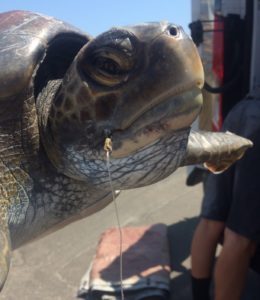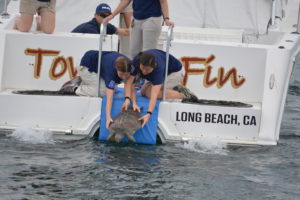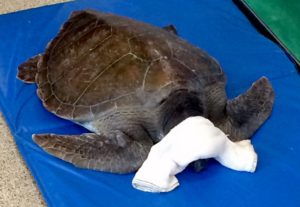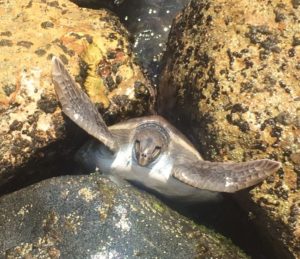Green Sea Turtles Invade
CWC’s first ever rescue of a marine reptile
By Marine Program Manager Jeff Hall

A hook can be seen extending from the mouth of this rescued sea turtle. it was caught on a fisherman’s pole, most likely after eating the bait on the hook, and reeled into shore. After the animal was rescued by the Marine Department, the hook was removed by staff at the Aquarium of the Pacific. Photo by Colleen Weiler
Sea turtles are usually something you’d see if you were snorkeling in Hawaii, or maybe during a leisurely catamaran ride off the coast of southern Mexico. While there are populations of sea turtles off the coast of California, you’d have to look pretty hard to actually come across one. Or you could just look at the end of a fishing pole in Malibu.
Two green sea turtles were rescued by CWC’s Marine Department this summer; both were hooked on the end of a fisherman’s pole. The first was rescued from Topanga Beach and the second was rescued from Malibu Pier. In both cases, the fishermen were more than a little shocked when then hauled in something unexpected. Both fishermen did the right thing and called CWC’s Emergency Hotline. Marine Program staff and volunteers headed out and rescued the hooked marine mammals. Both were transferred to the Aquarium of the Pacific in Long Beach for rehabilitation. Once admitted, the Aquarium staff took X-rays and discovered that the turtle rescued from Topanga Beach not only had a hook lodged in its mouth, it had also swallowed three more that were in its intestines. Those hooks complicated the rehab process, but they actually passed on their own and did not require surgery.

Staff and volunteers from the Aquarium of the Pacific were on hand to release two green sea turtles rescued by California Wildlife Center’s Marine Department. After short stays in rehabilitation at the aquarium, both turtles were returned to the wild after being given a clean bill of health. Photo courtesy of Aquarium of the Pacific

At the Aquarium of the Pacific, the turtle was X-rayed and more hooks were discovered. Photo by Jeff Hall
During the rehabilitation process, the turtles were given a PIT tag, similar to what you would give to your pet dog or cat. These tags contain unique identifying information about the turtles so that, in the future, if they are ever rescued or captured again, a more complete life history can be understood. After the sea turtles spent some time in the Aquarium of the Pacific’s rehabilitation pool, they were brought out to sea and released, hopefully without a hunger to eat fish off of a fisherman’s lines!

